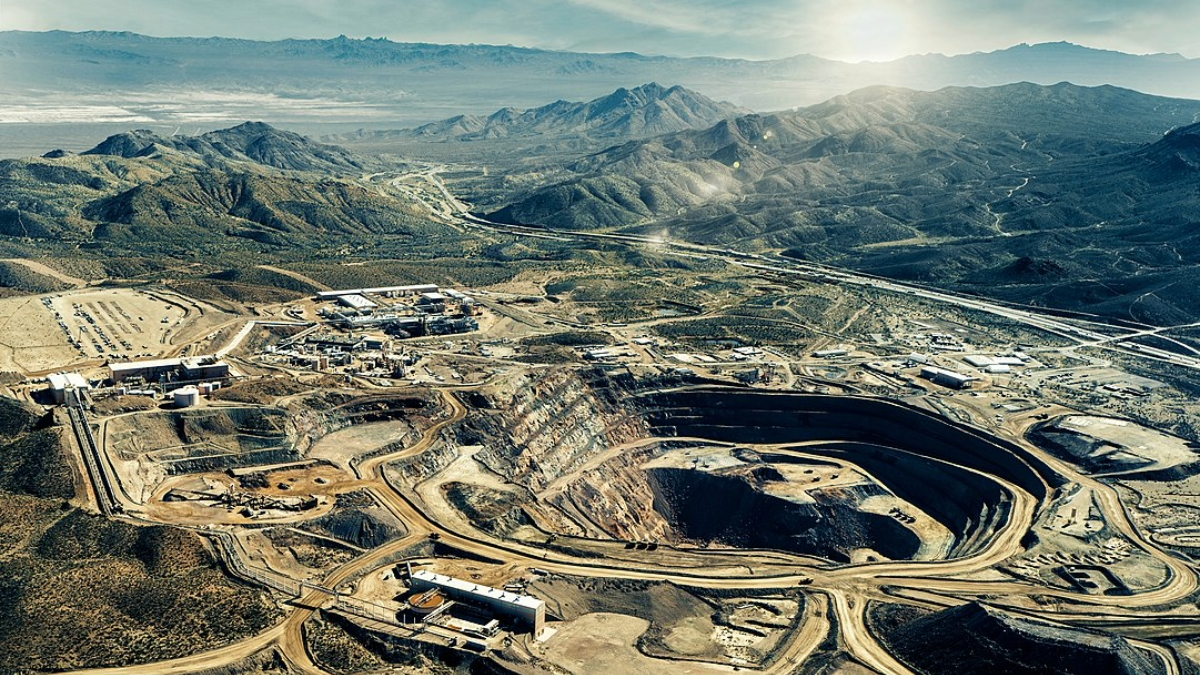The US Government Needs a More Coherent Strategy on Critical Minerals
William Xu, Daisuke Masuda / May 28, 2024
The Mountain Pass Rare Earth Mine & Processing Facility, owned by MP Materials, is the only active and scaled rare earth mining and processing facility in the United States. Photo by Tmy350, CC BY-SA 4.0.
The conversation on critical minerals — used in essentially all modern technologies, but especially important for electric vehicle (EV) batteries and other clean energy technologies — is heating up. Both the Washington Post and the New York Times reported on the importance and impending shortage of critical minerals for the clean energy transition last year, framing the problem in the context of geopolitical competition between the US and China. And in just the past year, several bipartisan bills on the topic were introduced in committees in both the House and the Senate.
The US has finally woken up to the reality that, over the past few decades, it has offshored the vast majority of its critical mineral supply chains while China has been building them up.
Scrambling to reduce dependence on China, the US government is now exploring policies and regulations aimed at ensuring a secure and independent supply of critical minerals that have been long overdue. However, these initiatives highlight the inherent contradictions in the nation’s policy goals around critical minerals, despite bipartisan support on the issue.
Let’s start by taking a look at domestic policy on critical minerals, which the Department of Energy (DOE) has championed thus far. Powered by the Bipartisan Infrastructure Law (BIL) and Inflation Reduction Act (IRA), the DOE has poured billions into building up domestic battery manufacturing capacity across the whole supply chain—in theory. So far, the first round of funding focuses primarily on downstream processing and battery material manufacturing, with only a couple upstream processing projects and nothing towards primary sourcing of minerals, i.e., actual mining.
Even the Advanced Research Projects Agency-Energy (ARPA-E), DOE’s DARPA equivalent, is focused primarily on mineral processing and mineral extraction from waste rather than mining due to lack of social acceptance, according to a DOE official. Mining Innovations for Negative Emissions Resources (MINER) is the primary program at ARPA-E tasked with promoting and funding projects related to critical minerals.
The government anticipates that initiatives funded by MINER will spur innovation in mining practices, delivering economic benefits while minimizing environmental and societal consequences, thereby enhancing public acceptance of mining activities in the US. And therein lies the fundamental tension—at least from the perspective of many liberals and certainly the Biden Administration—between advancing the clean energy transition and reducing reliance on geopolitical competitors for critical minerals on the one hand, and protecting the environment and indigenous rights on the other.
This tension is what led the Biden Administration to not approve any new mining projects in the past four years, and instead canceled several permits previously granted under the Trump Administration—such as a major proposed copper and nickel mine in Minnesota’s Boundary Waters Canoe Area Wilderness, where it imposed a mining ban. The easy solution for now has been to focus on mineral processing and manufacturing, which the US is severely lacking anyway.
As it stands, by backing innovative ways to extract minerals from raw ore or waste in an environmentally-friendly manner, MINER seems to be the only government program attempting to address these conflicting goals despite being subject to this tension itself. But there simply isn’t enough time to wait around – the window we have to decarbonize is shrinking, and the urgency to reduce US reliance on China is growing. Worse, critical minerals demand will outstrip supply in only a few years, while it takes on average 16 years to bring a mine online.
Of course, there is another way out of this conundrum: sourcing raw minerals from abroad through foreign investment and trade agreements.
It is notable that the electric vehicle (EV) tax credit provisions in the IRA require battery manufacturing to take place in North America, but expand the source of critical minerals used in EVs to all countries that the U.S. has a free trade or critical minerals agreement with. Unsurprisingly, the State Department has become greatly involved in the past few years.
As the importance of critical minerals has risen into the public and political consciousness, the State Department has substantially increased the number of officers focused on the topic, according to one official. In response to the 2021 Executive Order on America’s Supply Chains, the State Department established the Minerals Security Partnership (MSP) in 2022 to work towards its broad goal of establishing safe, sustainable sources of critical minerals that conform to high Environmental, Social, and Governance (ESG) standards.
Another key initiative the State Department official highlighted is the Partnership for Global Infrastructure and Investment (PGI), a G7 initiative through which the U.S. and European Union have announced support to develop the Lobito economic corridor. As many have previously reported, this initiative includes building up railroad capacity and transport infrastructure to connect cobalt and copper mines in the mineral-rich Democratic Republic of Congo (DRC) and Zambia to the Lobito port in Angola (on the west coast of Africa) in direct competition with China’s plans to invest in refurbishing an existing rail network that connects Zambia to the Dar es Salaam port in Tanzania (on the east coast of Africa).
Again, the underlying tension is evident: even as the Bureau of International Labor Affairs (ILAB) works to uphold labor rights articulated by the Biden Administration and to address the widely-reported human rights abuses in the DRC, the critical minerals the US needs have to come from somewhere.
International collaboration and investment will be vital, especially in mineral resource rich countries like the DRC and Zambia that the US historically avoided. But it may be too late to catch up to China, which has been investing in foreign and domestic critical mineral supply chain development for decades thanks to its industrial policy. That reality is especially daunting in the framing of the critical minerals race as part of the great power competition with China.
But even though fear of China’s rise on the global stage has been the main driver for bipartisan political action on critical mineral supply chains, Rod Ewing, Professor in Earth and Planetary Sciences and Co-director of the Center for International Security and Cooperation at Stanford University, told us in an interview that he believes cooperation with China is not only critical for the clean energy transition, but also for diffusing rising geopolitical tensions. Climate change is too important of a challenge facing humanity—all hands are needed on deck, working together.
Even if the US were to compete with China, Ewing doesn’t believe that it can catch up to China on clean energy technologies and critical mineral supply chains without some level of cooperation. Certainly, his views are shaped by his extensive background in nuclear waste disposal and nuclear weapons policy, but it was hard not to feel the weight of the words he left us with: “The US can’t win the competition. What would you win, a war? What do you win in a war [with China]?”
Some have referred to the dawn of this new geopolitical era as a “green great game” that could lead the US into a new Cold War with China. If that is where the world is headed, and the challenge of critical mineral supply chains is a catalyst, then Ewing may have the right idea. Even as the US should heed lessons from the Cold War, it is clear that the current economic intertwinement of the US and China and the looming backdrop of climate change make this global power struggle unprecedented.
The US faces a new challenge: the global competition for critical minerals. Most people working on critical minerals in the US today had never even heard of the term several years ago. Despite steps in the right direction, US government initiatives on critical minerals fail to address the inherent tension between its stance on resource extraction and the environment and human rights, as well as its emphasis on the importance of addressing climate change—which necessitates cooperation—and competition with China. The government needs to develop and implement a coherent, cross-cutting strategy – yesterday.
Thankfully, the Intergovernmental Critical Minerals Task Force Act, which would establish a dedicated task force made up of members across all relevant federal agencies (working in concert with all levels of government) to devise and carry out policy recommendations for improving US critical mineral supply chains, is designed to do just that. The bill, introduced in the Senate last year with its companion bill recently introduced in the House, has bipartisan support. It is long past time the US government had an explicit task force to work on critical minerals, especially considering this is a bipartisan issue.
Without a clear mission and organized strategy, the US will only become more tangled in its own web of conflicting goals. The country will continue to fall further behind China on critical minerals sourcing and clean energy technologies, drastically delaying climate change mitigation—and, perhaps worst of all, stumbling into a new Cold War.
Authors

